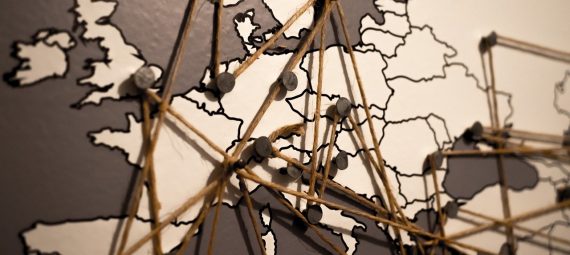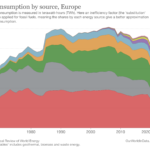Johannes Eber – Good morning Europe blog
Which tasks do we need the European Union for? The short answer is (here is the long one): We need the European Union to produce those public goods that extend beyond the nation state (here is an understandable explanation of what “public good” means).
Infrastructure can be such a good. If one country builds a cross-border railway line, its residents benefit from it. But not only theirs: the people in whose country the train route leads, benefit too. Though, since only the benefits of the building country’s population (voters) are regularly included in political decisions, too few cross-border train routes are built.
Cross-border cooperation can solve the problem. Two states will then finance the cross-border route, and the benefits of both countries will be taken into account when deciding whether to build such a route.
But what if not only the residents of two countries benefit from a cross-border route? An example: Italy and Switzerland are considering building a railway tunnel between their countries. Both countries would benefit. But others, too. For example, Germany. Germans could then get to Italy faster. But the benefits for Germany would not be included in the decision-making process for building the tunnel. The construction may then not take place. If the total costs were higher than the benefits for Italians and Swiss, the two governments would, for rational reasons, refrain from building the tunnel.
But the construction of the tunnel could make perfect sense anyway. Exactly when the overall benefit of the tunnel (added benefit of everyone who will use the tunnel in the future) is higher than the construction costs. Then, a larger community of countries is necessary to realise the tunnel construction. The European Union is needed.
This is why a European rail network should be the European Union’s responsibility.For better infrastructure. For better climate protection.
The European Union set the goal to be climate-neutral by 2050. Transport accounts for a quarter of the EU’s greenhouse-gas emissions. The European Green Deal seeks a 90 per cent reduction in these emissions by 2050.
That can only be achieved through drastic measures.
Such a drastic measure would be a dedicated European green high-speed train network, the Ultra-Rapid-Train (URT), with four routes cutting travel times between EU capitals and regions. The Vienna Institute for International Economic Studies (wiiw), the Macroeconomic Policy Institute in Düsseldorf, and the Observatoire français des conjonctures économiques in Paris have made this proposal.

These are the lines of that proposal (see also map above, taken from the paper How to Spend it: Proposal for a European Covid-19 Recovery Programme ):
- Dublin-Paris via a ferry-based sea link between Cork and Brest, taking on an additional significance in the context of Brexit (green)
- Lisbon-Helsinki including a loop around the Baltic Sea meeting in the Ruhr area (red)
- Brussels-Valletta, (blue)
- Berlin-Nicosia, with a ferry-based sea link between Piraeus and Paphos and a loop between Vienna and Sofia (brown)
According to the paper’s authors, such a network would cost an estimated 550 billion euros.
Some more details (from the paper):
“The URT network should be a new double-track high-speed railway system that is complementary to the existing networks. However, where suitable, also existing lines could be adapted. An average speed in the range of 250–350 km/h should be achieved. This would allow passengers to halve the current rail travel times, for instance, from Paris to Berlin to about four hours, making air travel for a large part of the intra-European passenger transport obsolete. Cutting by around half the EU’s domestic air passenger operations has the potential to reduce global commercial aviation CO2 emissions by about 4–5 percentage points. In addition, rail cargo capacities would be increased, freight transport speeded up and so also road-vehicle emissions reduced.”
Such a network would achieve several goals the EU has set. Once again, the authors:
- “to act as an anti-cyclical construction project to counter the economic fall-out from the current crisis and an expected secular stagnation;
- to provide EU citizens with a concrete benefit that satisfies their need for fast inner-European transport while avoiding as far as possible air transport;
- to represent a pan-European activity to foster European integration and cohesion;
- to constitute a lighthouse project in support of the European Green Deal’s aim of ‘accelerating the shift to sustainable and smart mobility, complementing efforts to decarbonise electricity generation;
- to bridge the technological gap vis-à-vis China in the development of high-speed train technology as well as providing a response but also a link to the Chinese Belt and Road Initiative;
- to create another European champion in the transport industry in line with the 2019 Franco-German Manifesto for a European industrial policy fit for the 21st Century.”
How likely is the implementation of this project? Not very likely. Although there would actually be the possibility of implementation. The EU’s Recovery and Resilience Facility is founded to help the EU emerge stronger and more resilient from the current crisis. The money shall support the green (and digital) transition by financing large-scale investment in infrastructure. Overall funds of more than 720 billion euros are available in loans and grants.
However, cross-border rail transport will probably not be built with that money. The reason: Mainly not the EU will decide what to spend the money for but the individual EU member states. They will deliver national plans, with primarily national projects. “There are hardly any projects with European value added, crossing borders, although network infrastructure typically yields the highest social returns,” Katharina Weber, Maximilian Zangl and Mario Holzner write on Social Europe.
Obviously, there is a bug in the system. The EU’s Recovery and Resilience Facility finances what national governments want. It was determined beforehand how much money a country gets. In this sense, the EU’s Recovery and Resilience Facility only serves for redistribution between countries. Public goods that extend beyond the nation state will be underrepresented. A wasted opportunity.
Author Profile

-
Founder of the "Good morning Europe blog" and Pixel economist
Guest author for European Liberals for Reform
Johannes' articles are originally written for the “Good morning Europe” blog (www.goodmorningeurope.org) and the Pixel economist (https://thepixeleconomist.substack.com).
We were given permission to publish his articles on the European Liberals for Reform blog.
Latest entries
Post Disclaimer
The opinions expressed by the author of this post do not necessarily represent the opinions and policies of ELfR.




